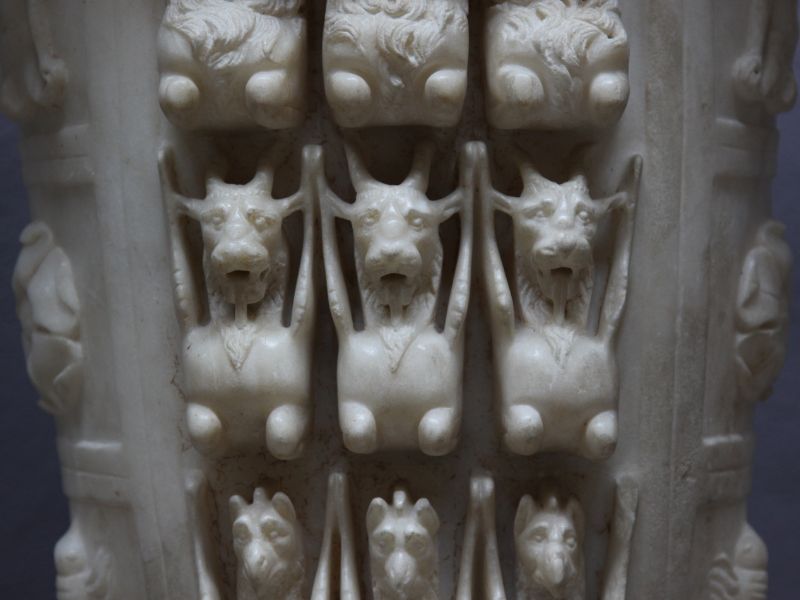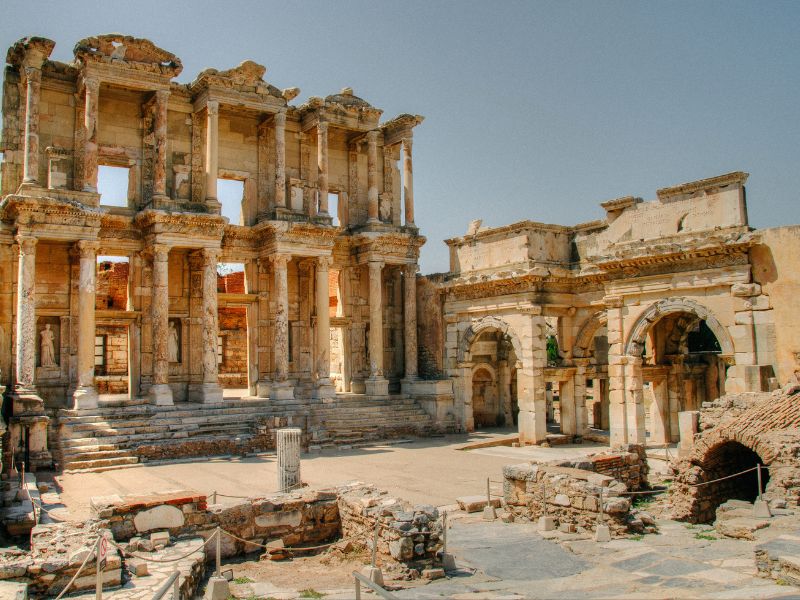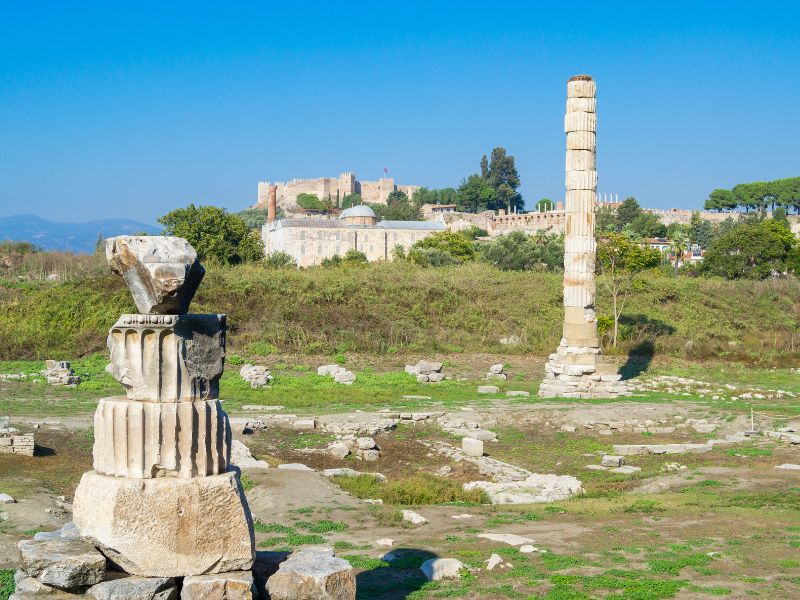Introduction
Stepping into the realm of ancient wonders, the Temple of Artemis at Ephesus holds a revered place in history as one of the Seven Wonders of the Ancient World. Located in what is now the modern-day country of Turkey, this architectural marvel once exemplified the pinnacle of Greek temple construction, dedicated to Artemis, the goddess of the hunt, wilderness, childbirth, and virginity.
Despite its eventual decline through the ages, the story of this temple encapsulates the cultural and religious zeitgeist of its era, leaving a legacy that continues to fascinate historians, archaeologists, and travelers alike.
This introduction aims to unfold the rich tapestry of history, architectural innovation, and cultural significance that the Temple of Artemis at Ephesus represents, inviting readers on a journey through time to unravel the mysteries of this ancient wonder.
Temple of Artemis at Ephesus: The History of an Architectural Marvel
The Temple of Artemis at Ephesus stands as a testament to the grandeur and creativity of ancient civilizations, meriting its place among the Seven Wonders of the Ancient World. Not only was this temple an architectural marvel, but it also played a central role in the religious and cultural life of Ephesus.
The temple’s story is intertwined with legend, notably the account from Plutarch that the temple burned down on the very night Alexander the Great was born, a tale that adds mystique to its historic significance.
Ancient Devotion: The Early History of Artemis at Ephesus

The worship of Artemis in Ephesus traces back to the Bronze Age, long before the magnificent temple was erected to honor her. This ancient deity, whose reverence spread throughout the Greek world, was deeply rooted in the cultural fabric of Ephesus.
Unlike the chaste huntress known in other regions, Ephesian Artemis was a multifaceted goddess embodying aspects of fertility, nature, and protection. Early iterations of her sanctuary were humble compared to the later grandeur, yet they laid the foundational spiritual significance of the site.
The evolution of the Temple of Artemis, from these modest beginnings to one of the most splendid constructions of the ancient world, mirrors the growth of Ephesus itself, from a small trading port to a pivotal center of commerce and religion.
Key to understanding the temple’s early history is the acknowledgment of its role as a beacon for pilgrims. The annual festival in honor of Artemis drew thousands from across the Aegean and beyond, transforming the city into a bustling hub of activity and reinforcing the temple’s status as a central figure in the ancient religious landscape.
Knowledge and Faith: Ephesus in the Ancient World
The city of Ephesus, with the Temple of Artemis at its heart, was a fusion of knowledge and faith, acting as a crucible for both the spiritual and the intellectual pursuits of the ancient world.
Renowned for its library, which was one of the largest and most significant in the ancient world, Ephesus became a center for scholarly activity, drawing philosophers, scientists, and historians. This intellectual milieu coexisted with the city’s deep-rooted religious traditions, showcasing a community where the pursuit of knowledge and the devotion to the divine enhanced each other.
This symbiosis between faith and knowledge enabled Ephesus to prosper as a hub of cultural, religious, and intellectual activity, attracting people from all corners of the ancient world. The city’s architecture, including the magnificent Temple of Artemis, reflected this blend of influences, incorporating advancements in engineering and design with religious symbolism.
The combination of these elements made Ephesus a symbol of the ancient world’s complexity, where diverse cultures, beliefs, and ideas could interact and flourish.
Ephesus’s significance in the ancient world cannot be overstated, serving not only as a religious center but also as a beacon of learning and culture. Its legacy, epitomized by the Temple of Artemis, continues to captivate the imagination of modern-day historians and archaeologists, embodying the ancient world’s richness and diversity.
The Goddess: Ephesian Artemis and Her Cult

Ephesian Artemis, distinguishable from her Greek counterpart, was a deity of many facets, embodying fertility, nature, and wildlife, while also acting as a guardian of the city and its people.
Unlike the virginal huntress associated with the Greek Artemis, the Ephesian manifestation revealed a more complex and encompassing deity, deeply interwoven with local beliefs and practices. This veneration underscores the adaptation and integration of deities within different cultural contexts, showcasing the fluidity and diversity of ancient religious worship.
At the heart of her cult was the magnificent Temple of Artemis at Ephesus, a place that not only served as a major site of worship but also as a sanctuary for those seeking refuge, emphasizing the goddess’s protective nature.
The cult of Artemis played a pivotal role in Ephesian society, with her annual festival attracting thousands of pilgrims and contributing significantly to the city’s economic and social vitality.
The unique image of Artemis, adorned with multiple breast-like bulges on her chest, believed to symbolize fertility and abundance, further reflects the local interpretation and syncretism of her persona. This distinct iconography, unlike any found elsewhere in the Greek or Roman world, highlights the special status and power attributed to Ephesian Artemis.
Her worship extended beyond the confines of the city, influencing the religious practices across Asia Minor and contributing to a shared cultural and spiritual heritage in the region.
The enduring legacy of the Temple of Artemis and its goddess serves as a testament to the profound impact of religious belief on ancient civilizations, bearing witness to the timeless human need for connection with the divine.
The Temple Through Different Eras

The Temple of Artemis navigated through various eras, each leaving a distinctive imprint on its architectural magnificence and spiritual significance. Initially, the temple’s inception during the Bronze Age laid a primitive foundation that would evolve into a monumental site, reflecting Ephesus’s growing importance.
The Archaic period saw the construction of a more substantial temple, which, despite its eventual destruction, underscored the community’s dedication to Artemis. By the Classical era, the Temple of Artemis had been rebuilt on an even grander scale, symbolizing the zenith of Ephesus’s power and the deep-rooted veneration of its goddess.
This version of the temple, financed by the Lydian king Croesus, was renowned throughout the ancient world for its breathtaking dimensions and exquisite craftsmanship, featuring columns that soared high and a facade richly adorned with sculpture. The Hellenistic period brought further enhancements to the temple, despite the challenges posed by Alexander the Great’s conquests.
The city’s rulers and inhabitants continued to honor Artemis, ensuring the temple remained a vital religious center. Throughout the Roman era, the temple’s fame only grew, attracting visitors from across the empire. Even as Christianity began to spread, the Temple of Artemis maintained its significance, serving as a link between the pagan past and the increasingly Christian present.
However, the temple’s fortune waned in the Byzantine era, as shifting religious and political tides led to neglect and eventual ruin. The once-glorious monument faced plunder and destruction, its materials repurposed for new buildings as the worship of Artemis faded into mythology.
Despite its physical decline, the Temple of Artemis’s legacy endured, its story encapsulating the ebb and flow of human civilization.
Through changing eras, it stood as a testament to the enduring human desire to reach beyond the mortal realm and connect with something divine—a desire that continues to draw people to its remnants, seeking a glimpse into a past where gods walked among humans.
The Temple’s Grandeur: An Architectural Marvel

- Ingenious Design: The Temple of Artemis stood as a marvel of ancient architecture, its grandeur and intricate design reflecting the ancient world’s ingenuity. It was a symbol of the religious devotion and aesthetic values of the time, embodying beauty and spiritual significance.
- Architectural Mastery: Constructed with over 127 marble columns, each 18 meters tall, and a cedar wood roof, the temple showcased Ephesus’s wealth, power, and technological advancements. Its majestic presence, visible from afar, served as a beacon for pilgrims and travelers.
- Innovative Styles: The temple harmoniously blended Ionic, Doric, and Corinthian architectural styles, making it a pioneering structure of its era. Sculptural reliefs and friezes adorned its exterior, depicting mythological scenes and celebrating Ephesian glory.
- Cultural Significance: Inside, the temple housed a unique statue of Artemis, emphasizing fertility with its multiple breast-like bulges, symbolizing abundance. The interior also contained votive offerings and treasures, enhancing its reputation as a rich and magnificent sanctuary.
- Functionality and Flow: Its design facilitated a natural flow of worshippers, accommodating large crowds during festivals and ceremonies. This functional aspect, combined with its symbolic and artistic elements, exemplifies the holistic nature of ancient sacred architecture.
- A Testament to Ancient Achievements: The Temple of Artemis is considered one of the Seven Wonders of the Ancient World due to its unprecedented scale, artistic beauty, and architectural innovation. It epitomized the height of ancient religious architecture, showcasing human capability to create structures that were not only functional but also deeply symbolic and aesthetically pleasing.
The Decline and Dissolution of the Temple
The end of the Temple of Artemis was marked by a confluence of events that reflected broader shifts in the Roman Empire and the ascendance of Christianity. Although the temple had withstood numerous challenges over the centuries, including raids, fires, and natural disasters, it was the changing religious landscape that ultimately led to its decline.
By the 4th century AD, Christianity had become the dominant religion of the empire under Constantine the Great, leading to a gradual decrease in pagan worship and the neglect of its temples. The final blow came in the form of a decree by Theodosius I, which ordered the closure of all pagan sanctuaries.
Subsequent attacks and sackings by Goths and Christians stripped the temple of its remaining treasures and materials. What was once the pride of Ephesus and a center of worship for the ancient world fell into disrepair and was eventually abandoned.
Over time, the remaining structures were repurposed or destroyed, and the great temple was lost to history, its ruins covered by the advancing soil and vegetation. It wasn’t until the 19th century that archaeological efforts began to uncover the temple’s foundations, providing insight into its past grandeur but also the magnitude of its loss.
Modern-Day Exploration: What Visitors Can See Today
Experience the magic of ancient history on an exclusive guided tour of Ephesus, including the mesmerizing Temple of Artemis, a UNESCO World Heritage site. Starting from the comfortable pick-up points at Kuşadası Port or directly from your hotel in Kusadasi or Izmir, this tour promises an unforgettable journey into the heart of Turkey’s ancient civilization.
About this Epic Journey
- Duration: Approximately 4 hours of immersive history and culture.
- Language Options: Expert guidance available in English, Spanish, Russian, and Portuguese.
- Flexibility: Free cancellation up to 24 hours in advance. Book now & decide later.
- Convenience: Skip the ticket lines and enjoy more time exploring.
- Transport: Travel in style with air-conditioned coaches from pick-up to drop-off locations.
Your Itinerary Highlights
- Ephesus: Kick-start your adventure with a 30-minute drive to Ephesus, witnessing the impressive ruins of the largest open-air museum in Turkey. Explore over 30 historical buildings and structures, where the whispers of ancient chariot wheels still echo through the streets.
- The Great Theatre: Marvel at the grandeur of the Great Theatre, where once 25,000 spectators watched theatrical performances and gladiatorial contests.
- Library of Celsus: Snap the perfect photo in front of the beautifully restored facade of the Library of Celsus, an ancient marvel.
- Temple of Artemis: The highlight of this tour, visit the site of one of the ancient world’s Seven Wonders. Stand before the lone remaining column of the once-magnificent temple, and feel the history beneath your feet.
What’s Included
- Hotel Pickup and Drop-off: Available for private tours.
- Guide: Learn the rich history of Ephesus and the Temple of Artemis from local experts.
- Admission Fees: Included, with skip-the-line access to keep your adventure smooth.
Important Information
- What to Bring: Don’t forget your passport or ID card.
- Meeting Points: Choose between Kuşadası Port or direct hotel pickup.
- Not Allowed: Keep the ancient sites pristine by not smoking in the vehicle.
Discover the essence of ancient Turkey with us, walking in the footsteps of Romans, early Christians, and mythological gods. The Temple of Artemis tour blends the perfect mix of history, culture, and breathtaking architecture, promising an experience that’s as enriching as it is memorable.
5 fun facts about the Temple of Artemis at Ephesus
- Monumental Size: The Temple of Artemis was one of the largest temples of the ancient world, about four times the size of the Parthenon in Athens.
- Wonder of the World: It was listed as one of the Seven Wonders of the Ancient World due to its incredible size and artistic features.
- Rich Decorations: The temple was adorned with sculptured columns and magnificent artworks, including a statue of Artemis decorated with gold and silver.
- Repeated Rebuilds: The temple was built and rebuilt several times due to destructions by fire, flood, and human attacks, showcasing the dedication to its magnificence and the goddess Artemis.
- Cultural Melting Pot: Artemis was worshipped at the temple in a form that blended local and Greek traditions, making her a symbol of cultural synthesis in Ephesus.
Conclusion
The Temple of Artemis at Ephesus, one of the Seven Wonders of the Ancient World, symbolizes the architectural and spiritual heights achieved by ancient civilizations. Despite its ruin, the temple’s legacy continues to fascinate, thanks to archaeologists and historians who preserve its story, offering insights into past cultural and religious practices.
Its significance lies in its monumental beauty and as a testament to human ingenuity and devotion, making it an enduring treasure that captivates visitors.

